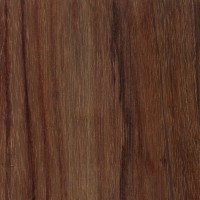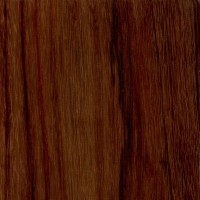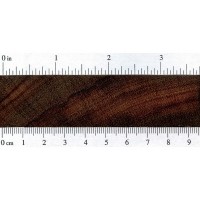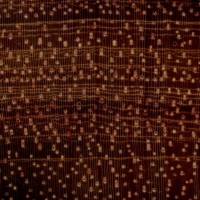 |
Common Name(s): Wamara, Guyana Rosewood Scientific Name: Swartzia spp. (S. benthamiana, S. leiocalycina) Distribution: Southern Mexico, Central America, and northern South America Tree Size: 100-130 ft (30-40 m) tall, 2-4 ft (.6-1.2 m) trunk diameter Average Dried Weight: 67 lbs/ft3 (1,080 kg/m3) Specific Gravity (Basic, 12% MC): .92, 1.08 Janka Hardness: 3,660 lbf (16,260 N) Modulus of Rupture: 28,490 lbf/in2 (196.5 MPa) Elastic Modulus: 3,535,000 lbf/in2 (24.38 GPa) Crushing Strength: 15,260 lbf/in2 (105.3 MPa) Shrinkage: Radial: 4.7%, Tangential: 7.6%, Volumetric: 12.3%, T/R Ratio: 1.6 |
Color/Appearance: Heartwood varies from medium reddish brown to purplish black, frequently with darker contrasting stripes. Sapwood is sharply demarcated and is a pale yellowish white.
Grain/Texture: The grain is usually straight, but can also be irregular or interlocked. With a fine even texture and good natural luster.
Endgrain: Diffuse-porous; large pores in no specific arrangement, very few; solitary and radial multiples of 2-3; heartwood deposits of varying colors commonly present; parenchyma winged, confluent, and banded (sometimes reticulate); narrow rays, fairly close spacing.
Rot Resistance: Varies depending upon species, but generally very durable. Heartwood is usually considered to have a high resistance to decay and termites; though it is susceptible to marine borers.
Workability: Wamara is typically considered difficult to work on account of its high density. The wood has a moderate to high blunting effect on cutters, and if there is interlocked grain present, tearout can occur during planing. Can be troublesome to glue because of its high density and natural oils present.
Odor: Wamara has a very faint odor when being worked.
Allergies/Toxicity: Wamara has been reported to cause respiratory irritation in some individuals. See the articles Wood Allergies and Toxicity and Wood Dust Safety for more information.
Pricing/Availability: Usually available in turning squares or as figured lumber (generally with a large amount of sapwood present). Expect prices to be in the mid to upper range for an imported tropical hardwood.
Sustainability: This wood species is not listed in the CITES Appendices or on the IUCN Red List of Threatened Species.
Common Uses: Inlays, fine furniture and cabinetry, parquet flooring, turnings, and other small specialty items.
Comments: Sometimes called Guyana Rosewood for its lustrous, dense, and colorful wood, Wamara technically isn’t a true rosewood (Dalbergia genus), but is in what could arguably be viewed as one of the most under-appreciated genera of tropical hardwoods: Swartzia. This genus is filled with a variety of colorful and striped woods, most of which remain obscure.
Wamara is very closely related to the more widely known hardwood: Katalox (Swartzia cubensis). Both woods possess superb strength properties, though Wamara tends to be more variable in coloration and appearance, frequently sporting dark contrasting stripes.
Scans/Pictures: A special thanks to Justin Holden for providing the wood sample of this wood species.








I have found a log in the skip of my local timber supplier, and I thought it was just a very dirty piece of hardwood, but when I cut a slither off the log I was very surprised to see the darkness of the wood. I do not know what type of wood it is, but it weighs around 1.1kg per litre, so is very heavy. It looks a bit like Wamara, but I’m not sure.
anyone able to help identify this log (pictures below)
It looks like ekki to me. https://www.wood-database.com/ekki/
This looks like “bruinhart” from Surinam
Also called Vouacapoua americana of Wacapu
I have a board of this, it was sold under the name Brazilian Ebony. Warmoth also refers to this wood as that: https://www.warmoth.com/Guitar/Necks/NeckWoodsPop.aspx